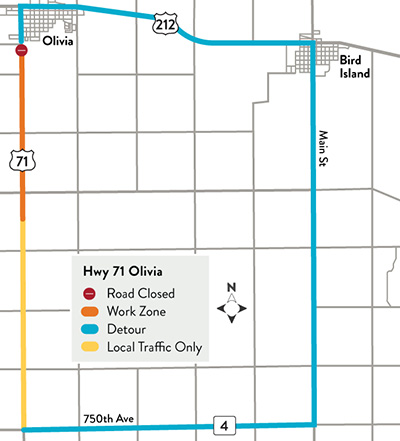About this project
Summary of work
- Install a weigh-in-motion sensor system plus two pull-off locations on Hwy 71 south of Olivia between Bayberry Ave and .5 miles south of 790th Ave
- System sensors will allow truck weights to be collected while the vehicle is in motion
- Pull off locations provide a safe area for law enforcement to perform stationary weigh-ins north and south of the weigh-in-motion sensor
Traffic impacts
A detour will be in place for approximately
one month
From the north
- Hwy 212 to CR 5 to 750th Ave to Hwy 71
From the south
- Hwy 71 to 750th Ave to CR 5 to Hwy 212
What is a Weigh-in-Motion (WIM) System?
How it works:
A WIM system uses sensors embedded in the pavement to detect the pressure exerted by vehicles driving over them. In the system we are installing near Olivia, there will be four sensors in each lane, along with a few loop detectors. Loop detectors are embedded coils in the pavement that detect the presence of vehicles by sensing changes in the electromagnetic field when a vehicle passes over them. These sensors, combined with electronics and software, help estimate the weight and tire condition of a vehicle.
Purpose:
WIMs help prevent early road wear by checking vehicle weights without stopping traffic. They are mainly used as screening tools. While WIMs are generally accurate, things like a vehicle’s speed, acceleration, braking, bouncing, or even wind can affect the readings. Because of this, WIMs data alone is not used to issue tickets.
Next steps when issues are flagged:
If a WIM flags a potential issue, such as overweight vehicles or bad tires, the vehicle is not immediately cited. Instead, a law enforcement officer must stop the vehicle, weigh it on certified scales, and conduct a physical inspection to determine if further action is needed.
Ensuring fair and efficient screening:
WIMs are designed to screen all vehicles regardless of type or use, ensuring that weight and safety regulations are enforced fairly and evenly. Vehicles passing through the system are screened based on their characteristics, not their purpose or ownership. This system helps ensure compliance while minimizing disruptions for law-abiding vehicles.
Longstanding use of WIMs:
WIM systems, like the one on Highway 212 east of Olivia have been in use for many years, helping maintain safety and compliance across a wide range of vehicles. These systems are strategically placed to ensure broad coverage without focusing on any specific group of drivers.
Cost-effective enforcement:
Building and maintaining weigh stations is expensive. Due to land and staffing costs, it is not practical to have a weigh station in every part of the state. WIMs offer an efficient alternative for weight and safety enforcement in areas without a weigh station. (Note: There are no weigh stations in District 8)
Benefits of WIMs:
Efficiency:
WIMs check vehicle weights while trucks stay in motion. This means compliant vehicles keep moving, reducing delays and focusing enforcement on trucks that may need attention.
Fewer disruptions:
Without WIMs, checking vehicle weights can lead to more traffic delays. WIMs help law enforcement focus on vehicles that may be overweight, keeping compliant trucks moving and traffic flowing smoothly.
